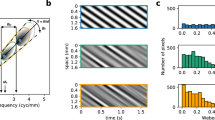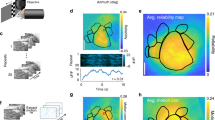Abstract
Simulating large-scale models of biological motion perception is challenging, due to the required memory to store the network structure and the computational power needed to quickly solve the neuronal dynamics. A low-cost yet high-performance approach to simulating large-scale neural network models in real-time is to leverage the parallel processing capability of graphics processing units (GPUs). Based on this approach, we present a two-stage model of visual area MT that we believe to be the first large-scale spiking network to demonstrate pattern direction selectivity. In this model, component-direction-selective (CDS) cells in MT linearly combine inputs from V1 cells that have spatiotemporal receptive fields according to the motion energy model of Simoncelli and Heeger. Pattern-direction-selective (PDS) cells in MT are constructed by pooling over MT CDS cells with a wide range of preferred directions. Responses of our model neurons are comparable to electrophysiological results for grating and plaid stimuli as well as speed tuning. The behavioral response of the network in a motion discrimination task is in agreement with psychophysical data. Moreover, our implementation outperforms a previous implementation of the motion energy model by orders of magnitude in terms of computational speed and memory usage. The full network, which comprises 153,216 neurons and approximately 40 million synapses, processes 20 frames per second of a 40 × 40 input video in real-time using a single off-the-shelf GPU. To promote the use of this algorithm among neuroscientists and computer vision researchers, the source code for the simulator, the network, and analysis scripts are publicly available.









Similar content being viewed by others
References
Adelson, E. H., & Bergen, J. R. (1985). Spatiotemporal energy models for the perception of motion. Journal of the Optical Society of America A, 2(2), 284–299.
Adelson, E. H., & Movshon, J. A. (1982). Phenomenal coherence of moving visual patterns. Nature, 300(5892), 523–525.
Bradley, D. C., & Goyal, M. S. (2008). Velocity computation in the primate visual system. Nature Reviews Neuroscience, 9(9), 686–695. doi:10.1038/Nrn2472.
Browning, N. A., Grossberg, S., & Mingolla, E. (2009a). Cortical dynamics of navigation and steering in natural scenes: motion-based object segmentation, heading, and obstacle avoidance. Neural Networks, 22(10), 1383–1398. doi:10.1016/j.neunet.2009.05.007.
Browning, N. A., Grossberg, S., & Mingolla, E. (2009b). A neural model of how the brain computes heading from optic flow in realistic scenes. Cognitive Psychology, 59(4), 320–356. doi:10.1016/j.cogpsych.2009.07.002.
Burke, D., & Wenderoth, P. (1993). The effect of interactions between one-dimensional component gratings on 2-dimensional motion perception. Vision Research, 33(3), 343–350. doi:10.1016/0042-6989(93)90090-J.
Chey, J., Grossberg, S., & Mingolla, E. (1997). Neural dynamics of motion grouping: from aperture ambiguity to object speed and direction. Journal of the Optical Society of America a-Optics Image Science and Vision, 14(10), 2570–2594. doi:10.1364/Josaa.14.002570.
Chubb, C., & Sperling, G. (1988). Drift-balanced random stimuli—a general basis for studying non-fourier motion perception. Journal of the Optical Society of America a-Optics Image Science and Vision, 5(11), 1986–2007. doi:10.1364/Josaa.5.001986.
Dayan, P., & Abbott, L. F. (2001). Theoretical neuroscience: Computational and mathematical modeling of neural systems (Computational neuroscience). Cambridge: Massachusetts Institute of Technology Press.
DeAngelis, G. C., Ohzawa, I., & Freeman, R. D. (1993). Spatiotemporal organization of simple-cell receptive fields in the cat's striate cortex. II. Linearity of temporal and spatial summation. Journal of Neurophysiology, 69(4), 1118–1135.
Ferrera, V. P., & Wilson, H. R. (1990). Perceived direction of moving two-dimensional patterns. Vision Research, 30(2), 273–287.
Fidjeland, A. K., & Shanahan, M. P. (2010). Accelerated simulation of spiking neural networks using GPUs. In Neural Networks (IJCNN), The 2010 International Joint Conference on, 18–23 July 2010 (pp. 1–8). doi:10.1109/IJCNN.2010.5596678.
Freeman, W. T., & Adelson, E. H. (1991). The design and use of steerable filters. In IEEE Pattern Analysis and Machine Intelligence (Vol. 13, pp. 891–906).
Grossberg, S., & Pilly, P. K. (2008). Temporal dynamics of decision-making during motion perception in the visual cortex. Vision Research, 48(12), 1345–1373. doi:10.1016/j.visres.2008.02.019.
Hohl, S. S., Chaisanguanthum, K. S., & Lisberger, S. G. (2013). Sensory population decoding for visually guided movements. Neuron, 79(1), 167–179. doi:10.1016/j.neuron.2013.05.026.
Indiveri, G., Chicca, E., & Douglas, R. (2006). A VLSI array of low-power spiking neurons and bistable synapses with spike-timing dependent plasticity. IEEE Transactions on Neural Networks, 17(1), 211–221. doi:10.1109/Tnn.2005.860850.
Izhikevich, E. M. (2003). Simple model of spiking neurons. IEEE Transactions on Neural Networks, 14(6), 1569–1572. doi:10.1109/Tnn.2003.820440.
Izhikevich, E. M. (2004). Which model to use for cortical spiking neurons? IEEE Transactions on Neural Networks, 15(5), 1063–1070. doi:10.1109/Tnn.2004.832719.
Izhikevich, E. M. (2007). Dynamical systems in neuroscience: The geometry of excitability and bursting (Computational neuroscience). Cambridge: MIT Press.
Izhikevich, E. M., Gally, J. A., & Edelman, G. M. (2004). Spike-timing dynamics of neuronal groups. Cerebral Cortex, 14(8), 933–944. doi:10.1093/cercor/bhh053.
Khan, M., Lester, D., Plana, L., Rast, A., Jin, X., & Painkras, E. SpiNNaker: Mapping neural networks onto a massively-parallel chip multiprocessor. In IEEE International Joint Conference on Neural Networks, 2008 (pp. 2849–2856).
Koch, C. (1999). Biophysics of computation: Information processing in single neurons (Computational neuroscience). New York: Oxford University Press.
Layton, O. W., Mingolla, E., & Browning, N. A. (2012). A motion pooling model of visually guided navigation explains human behavior in the presence of independently moving objects. Journal of Vision, 12(1), doi:10.1167/12.1.20.
Livingstone, M. S., & Conway, B. R. (2007). Contrast affects speed tuning, space-time slant, and receptive-field organization of simple cells in macaque V1. Journal of Neurophysiology, 97(1), 849–857. doi:10.1152/jn.00762.2006.
Lu, Z. L., & Sperling, G. (1995). Attention-generated apparent motion. Nature, 377(6546), 237–239. doi:10.1038/377237a0.
Majaj, N. J., Carandini, M., & Movshon, J. A. (2007). Motion integration by neurons in macaque MT is local, not global. Journal of Neuroscience, 27(2), 366–370. doi:10.1523/JNEUROSCI.3183-06.2007.
Merolla, P. A., Arthur, J. V., Shi, B. E., & Boahen, K. A. (2007). Expandable networks for neuromorphic chips. IEEE Transactions on Circuits and Systems I-Regular Papers, 54(2), 301–311. doi:10.1109/Tcsi.2006.887474.
Movshon, J. A., & Newsome, W. T. (1996). Visual response properties of striate cortical neurons projecting to area MT in macaque monkeys. Journal of Neuroscience, 16(23), 7733–7741.
Movshon, J. A., Adelson, E. H., Gizzi, M. S., & Newsome, W. T. (1985). The analysis of moving visual patterns (Pattern recognition mechanisms). New York: Springer.
Nageswaran, J. M., Dutt, N., Krichmar, J. L., Nicolau, A., & Veidenbaum, A. V. (2009). A configurable simulation environment for the efficient simulation of large-scale spiking neural networks on graphics processors. Neural Networks, 22(5–6), 791–800. doi:10.1016/j.neunet.2009.06.028.
Nishida, S. (2011). Advancement of motion psychophysics: review 2001–2010. Journal of Vision, 11(5), Artn 11. doi:10.1167/11.5.11.
Pack, C. C., Berezovskii, V. K., & Born, R. T. (2001). Dynamic properties of neurons in cortical area MT in alert and anaesthetized macaque monkeys. Nature, 414(6866), 905–908. doi:10.1038/414905a.
Perrone, J. A. (2012). A neural-based code for computing image velocity from small sets of middle temporal (MT/V5) neuron inputs. Journal of Vision, 12(8), doi:10.1167/12.8.1.
Perrone, J. A., & Thiele, A. (2001). Speed skills: measuring the visual speed analyzing properties of primate MT neurons. Nature Neuroscience, 4(5), 526–532.
Perrone, J. A., & Thiele, A. (2002). A model of speed tuning in MT neurons. Vision Research, 42(8), 1035–1051.
Priebe, N. J., Cassanello, C. R., & Lisberger, S. G. (2003). The neural representation of speed in macaque area MT/V5. Journal of Neuroscience, 23(13), 5650–5661.
Priebe, N. J., Lisberger, S. G., & Movshon, J. A. (2006). Tuning for spatiotemporal frequency and speed in directionally selective neurons of macaque striate cortex. Journal of Neuroscience, 26(11), 2941–2950. doi:10.1523/JNEUROSCI.3936-05.2006.
Raudies, F., Mingolla, E., & Neumann, H. (2011). A model of motion transparency processing with local center-surround interactions and feedback. Neural Computation, 23(11), 2868–2914. doi:10.1162/NECO_a_00193.
Resulaj, A., Kiani, R., Wolpert, D. M., & Shadlen, M. N. (2009). Changes of mind in decision-making. Nature, 461(7261), 263–U141. doi:10.1038/Nature08275.
Richert, M., Nageswaran, J. M., Dutt, N., & Krichmar, J. L. (2011). An efficient simulation environment for modeling large-scale cortical processing. Frontiers Neuroinformatics, 5, 19. doi:10.3389/fninf.2011.00019.
Rodman, H. R., & Albright, T. D. (1987). Coding of visual stimulus velocity in area Mt of the Macaque. Vision Research, 27(12), 2035–2048. doi:10.1016/0042-6989(87)90118-0.
Rodman, H. R., & Albright, T. D. (1989). Single-unit analysis of pattern-motion selective properties in the middle temporal visual area (MT). Experimental Brain Research, 75(1), 53–64.
Roitman, J. D., & Shadlen, M. N. (2002). Response of neurons in the lateral intraparietal area during a combined visual discrimination reaction time task. Journal of Neuroscience, 22(21), 9475–9489.
Rust, N. C., Mante, V., Simoncelli, E. P., & Movshon, J. A. (2006). How MT cells analyze the motion of visual patterns. Nature Neuroscience, 9(11), 1421–1431. doi:10.1038/Nn1786.
Shadlen, M. N., & Newsome, W. T. (2001). Neural basis of a perceptual decision in the parietal cortex (area LIP) of the rhesus monkey. Journal of Neurophysiology, 86(4), 1916–1936.
Simoncelli, E. P., & Heeger, D. J. (1998). A model of neuronal responses in visual area MT. Vision Research, 38(5), 743–761. doi:10.1016/S0042-6989(97)00183-1.
Smith, P. L., & Ratcliff, R. (2004). Psychology and neurobiology of simple decisions. Trends in Neurosciences, 27(3), 161–168. doi:10.1016/j.tins.2004.01.006.
Smith, M. A., Majaj, N. J., & Movshon, J. A. (2005). Dynamics of motion signaling by neurons in macaque area MT. Nature Neuroscience, 8(2), 220–228. doi:10.1038/Nn1382.
Srinivasa, N., & Cruz-Albrecht, J. M. (2012). Neuromorphic adaptive plastic scalable electronics analog learning systems. IEEE Pulse, 3(1), 51–56. doi:10.1109/Mpul.2011.2175639.
Thiele, A., Dobkins, K. R., & Albright, T. D. (2001). Neural correlates of chromatic motion perception. Neuron, 32(2), 351–358.
van Santen, J. P. H., & Sperling, G. (1985). Elaborated Reichardt detectors. Journal of the Optical Society of America a-Optics Image Science and Vision, 2(2), 300–321.
Vogelstein, R. J., Mallik, U., Culurciello, E., Cauwenberghs, G., & Etienne-Cummings, R. (2007). A multichip neuromorphic system for spike-based visual information processing. Neural Computation, 19(9), 2281–2300. doi:10.1162/neco.2007.19.9.2281.
Wilson, H. R., Ferrera, V. P., & Yo, C. (1992). A psychophysically motivated model for 2-dimensional motion perception. Visual Neuroscience, 9(1), 79–97.
Yudanov, D., Shaaban, M., Melton, R., & Reznik, L. (2010). GPU-based simulation of spiking neural networks with real-time performance & high accuracy. In Neural Networks (IJCNN), The 2010 International Joint Conference on, 18–23 July 2010 (pp. 1–8). doi:10.1109/IJCNN.2010.5596334.
Acknowledgments
This work was supported by the Defense Advanced Research Projects Agency (DARPA) subcontract 801888-BS. We thank Jayram M. Nageswaran for his work developing the custom spiking neural network simulator. We also thank Michael Avery, Kris Carlson, and Steve Grossberg for valuable feedback and discussion on this project.
Conflict of Interest
The authors have no conflicts of interest with this manuscript.
Author information
Authors and Affiliations
Corresponding author
Rights and permissions
About this article
Cite this article
Beyeler, M., Richert, M., Dutt, N.D. et al. Efficient Spiking Neural Network Model of Pattern Motion Selectivity in Visual Cortex. Neuroinform 12, 435–454 (2014). https://doi.org/10.1007/s12021-014-9220-y
Published:
Issue Date:
DOI: https://doi.org/10.1007/s12021-014-9220-y




